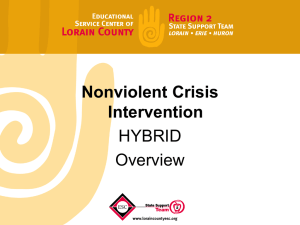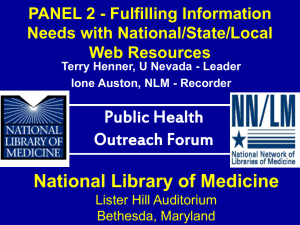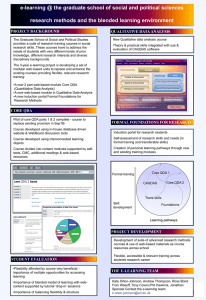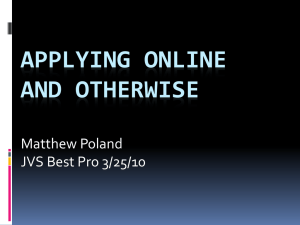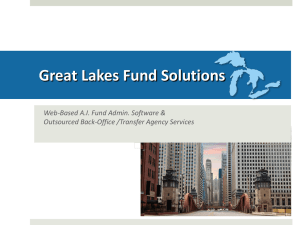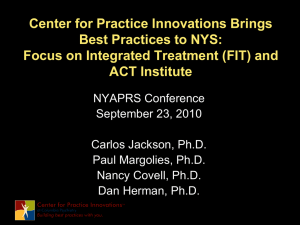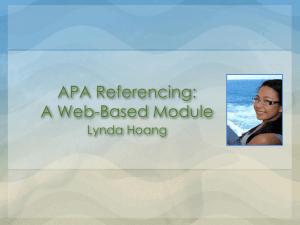PPTX
advertisement
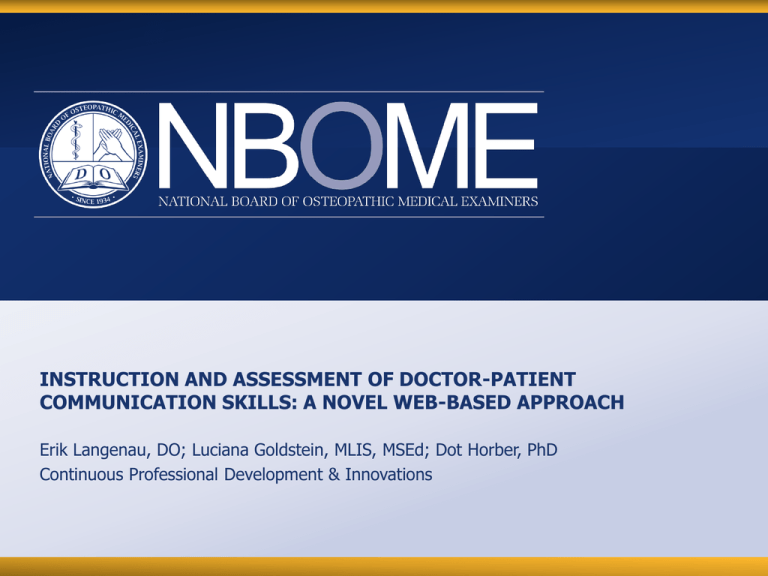
INSTRUCTION AND ASSESSMENT OF DOCTOR-PATIENT COMMUNICATION SKILLS: A NOVEL WEB-BASED APPROACH Erik Langenau, DO; Luciana Goldstein, MLIS, MSEd; Dot Horber, PhD Continuous Professional Development & Innovations www.nbome.org © 2012 NBOME Disclosures None to report www.nbome.org © 2012 NBOME Web-based communication module Description of Learning Need • Competency-based assessment for physicians – – – – – – – Patient care Medical knowledge Interpersonal and communication skills Professionalism Systems-based practice Practice-based learning and improvement Osteopathic principles and practice • Assessment needs – – – – Resident level assessment (ACGME and AOA competencies) Maintenance of Licensure (MOL) Maintenance of Certification (MOC) Osteopathic Continuous Certification (OCC) www.nbome.org © 2012 NBOME Web-based communication module Description of Learners • 58,000 Osteopathic Physicians in U.S. (7% of all physicians) • All physicians Wish to learn to improve the care of patients Are busy Participate in Continuing Medical Education (CME) Need to comply with new state medical board and specialty board requirements – Want educational activities which are relevant, practical, and easy to use. – – – – www.nbome.org © 2012 NBOME Web-based communication module Background: web-based communication • Increasing emphasis on competency-based assessment for physicians – Medical students – Residents – Practicing physicians • Increasing emphasis on doctor-patient communication skills (Teutsch, 2003; Duffy et al, 2004) • Increasing use of Objective Structured Clinical Examinations (OSCEs) (Boulet et al, 2009) • Emergence of “Web-OSCEs” (Daetwyer et al, 2010; Novack et al, 2002) www.nbome.org © 2012 NBOME Web-based communication module E-Learning Solution • Web-based communication assessment of doctor-patient communication skills • Remote Standardized Patients (RSPs) – Commonly used for education and assessment – Have been used by schools, residency and licensure • Many content areas could be considered: – – – – – – – – – Communication with child Communication with colleague Communication with teenager Cultural diversity Delivering bad news Empathy End of life/health care proxy Limited English proficiency Medical mistake www.nbome.org © 2012 NBOME Web-based communication module www.nbome.org © 2012 NBOME Web-based communication modules • • • • Communication-focused Skype Physicians receive – Verbal feedback – Global communication assessment – Communication skills checklist – Self-assessment – Teaching Points Implications for – CME – MOL – OCC – Resident Education www.nbome.org © 2012 NBOME Web-based communication module Short-term goal • Research • Purpose: To evaluate the effectiveness and user acceptance of a web-based educational module for doctor-patient communication skills www.nbome.org © 2012 NBOME Research Study: Web-based communication module Technologies used in the project • • • • • • • • • Email: – Scheduling, troubleshooting, updating – Training – Providing opportunity for RSPs to reach out to one another – Obtaining RSP availability – Training, technical support and live encounters – Recording encounters (screen capture) – Uploading videos – Standardize video and audio quality – Surveying (demographics, post-exercise experience) PowerPoint Listserv: Doodle: Skype: SuperTinTin: NBOME website: HP Webcam HD-2200: Survey Monkey www.nbome.org © 2012 NBOME Web-based communication module Physician Experience • Recruitment • Training documents – Skype Trouble Shooting – Encounter Instructions • Scheduling • Pre-encounter – Skype Username – Technology check – Case Introduction www.nbome.org © 2012 NBOME Web-based communication module Physician Experience (continued) • Encounter – – – – Doctor-patient communication (15 min) Self-assessment (5 min) Verbal Feedback (10 min) Support: 24-hour staff support (phone) • Post-encounter – Email Self-assessment – Receive email from NBOME staff • • • • Completed Global Assessment Completed Case-specific Checklist (Key Action) Completed Self-Assessment Teaching Points – Survey of Experience – Focus Group Discussion • NBOME Staff support throughout experience (phone, email and Skype) www.nbome.org © 2012 NBOME Web-based communication module Formative Assessment • Four assessments – Verbal feedback from remote SPs • Emphasis on teaching points for each case – Written Feedback • Communication key action assessment (key action checklist) • Global communication skills assessment – Likert-type scale • Self-assessment of global communication skills www.nbome.org © 2012 NBOME Web-based communication module Global Assessment • Informed by Essential Communication Elements, Kalamazoo Consensus Statement. – Duffy FD, Gordon GH, Whelan G, Cole-Kelly K, Frankel R. Assessing competence in communication and interpersonal skills: the Kalamazoo II report. Academic Medicine. 2004;79(6):495-507. • Case Development Committee www.nbome.org © 2012 NBOME Web-based communication module Case-Specific Checklist • Case Development Committee www.nbome.org © 2012 NBOME Web-based communication module Self-Assessment • Global Assessment • Modified for self assessment www.nbome.org © 2012 NBOME Web-based communication module Teaching Points Summary of Case Medical History Pain History Case-specific Information • References • • • • www.nbome.org © 2012 NBOME Web-based communication module Remote Standardized Patient (RSP) Training • Introduction to Osteopathic Medicine: 20 min – Review prerecorded PowerPoint Presentation • Case Training: 4-6 hours – – – – Portrayal Scoring (checklist and global assessment) Technology Delivering verbal feedback • Technology Check: 1 hour • Dress Rehearsal: 1 hour www.nbome.org © 2012 NBOME Web-based communication module Remote Standardized Patient (RSP) Experience • • • • • • Training documents – – – Technology Set Up Procedures Skype Trouble Shooting Encounter Instructions – – – Skype Username Skype Account SuperTinTin – – – – Doctor-patient communication (15 min) Complete evaluation forms (5 min) Verbal Feedback (10 min) Support: 24-hour staff support (phone) – – – Complete evaluations: checklist, global assessment, technology report Upload video to NBOME research website Survey of experience Scheduling Pre-encounter Encounter Post-encounter NBOME Staff support throughout experience (phone, email and Skype) www.nbome.org © 2012 NBOME Research Study: Web-based communication module Summary • Web-based communication formative assessment using RSPs • Authentic • Practice-relevant • Allows physicians to participate in a meaningful exercise, while potentially satisfying – Licensure requirements – Specialty board requirements for continuous professional development – Residency program requirements www.nbome.org © 2012 NBOME Research Study: Web-based communication module Next Steps • Analyze data – – – – – • Scoring Survey of Residents Survey of RSPs Focus Group of Residents Focus Group of RSPs Dissemination of findings www.nbome.org © 2012 NBOME Web-based communication module References • Accreditation Council on Graduate Medical Education. (2007). Common program requirements: general competencies. Retrieved from http://www.acgme.org/Outcome/comp/GeneralCompetenciesStandards21307.pdf . (Archived on 8 June 2011 at http://www.webcitation.org/5zIFGOLtn) • American Association of Colleges of Osteopathic Medicine. (April 6, 2012). Osteopathic Core Competencies for Medical Students: Addressing the AOA Seven Core Competencies and the Healthy People Curriculum Task Force’s Clinical Prevention and Population Health Curriculum Framework. Retrieved from http://www.aacom.org/InfoFor/educators/mec/cc/Documents/CoreCompetencyLiaisonProject_f inal%20draft.pdf. (Archived on 28 May 2012 at http://www.webcitation.org/6801oYQOq ) • American Osteopathic Association. (2004). Core Competency Compliance Program (CCCP) Part III. Retrieved from http://www.do-online.org/pdf/acc_cccppart3.pdf (Archived on 16 May 2012 at http://www.webcitation.org/67i2YR4Sg) • Chaudhry, H.J., Rhyne J., Cain, F.E., Young, A., Crane, M., & Bush, F. (2010). Maintenance of Licensure: Protecting the Public, Promoting Quality Health Care. Journal of Medical Regulation, 96, 1-8. • Daetwyer, C.F., Cohen, D.G., Gracely, D., & Novak, D.N. (2010). eLearning to enhance physician patient communication: a pilot test of “doc.com” and “WebEncounter” in teaching bad news delivery. Medical Teacher, 32, e374-e383. doi: 10.3109/-142159x.2010.495759. • Duffy, F.D., Gordon, G.H., Whelan, G., Cole-Kelly, K., & Frankel, R. (2004). Assessing competence in communication and interpersonal skills: the Kalamazoo II report. Academic Medicine, 79(6), 495-507. www.nbome.org © 2012 NBOME Web-based communication module References (cont) • Harasim, L. (2012). Learning theory and online technologies. New York, NY: Routledge. • National Board of Osteopathic Medical Examiners. (June 2011). Fundamental Osteopathic Medical Competency Domains Document. Retrieved from http://www.nbome.org/docs/NBOME%20Fundamental%20Osteopathic%20Medical%20Compet encies.pdf (Archived on 16 May 2012 at http://www.webcitation.org/67i2FI7pN • Novack, D.H., Cohen, D., Peitzman, S.J., Beadenkopf, S., Gracely, E., & Morris, J. (2002). A pilot test of WebOSCE: a system for assessing trainees' clinical skills via teleconference. Medical Teacher, 24(5), 483-7. doi: 10.1080.0142159021000012504. • Spagnoletti, C.L., Bui, T., Fisher, G.S., Gonzaga, A.M.R., Rubio, D.M., & Arnold, R.M. (2009). Implementation and evaluation of a web-based communication skills learning tool for training internal medicine interns in patient-doctor communication. Journal of Communication in Healthcare, 2(2), 159-172. • Turner, M.K., Simon, S.R., Facemyer, K.C., Newhall, L.M., Veach, T.L. (2006). Web-based Learning Versus Standardized Patients for Teaching Clinical Diagnosis: A Randomized, Controlled, Crossover Trial. Teaching and Learning in Medicine, 18(3), 208-214. www.nbome.org © 2012 NBOME THANK YOU www.nbome.org © 2012 NBOME Example Video www.nbome.org © 2012 NBOME

